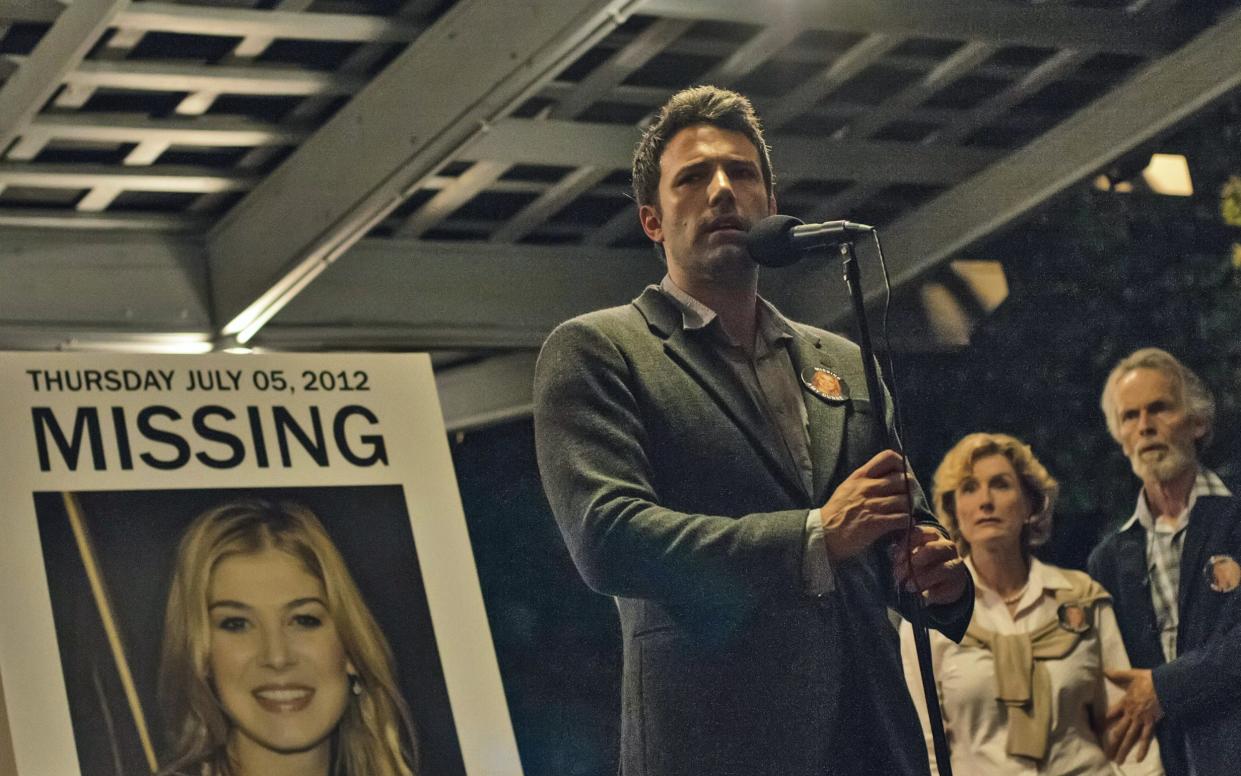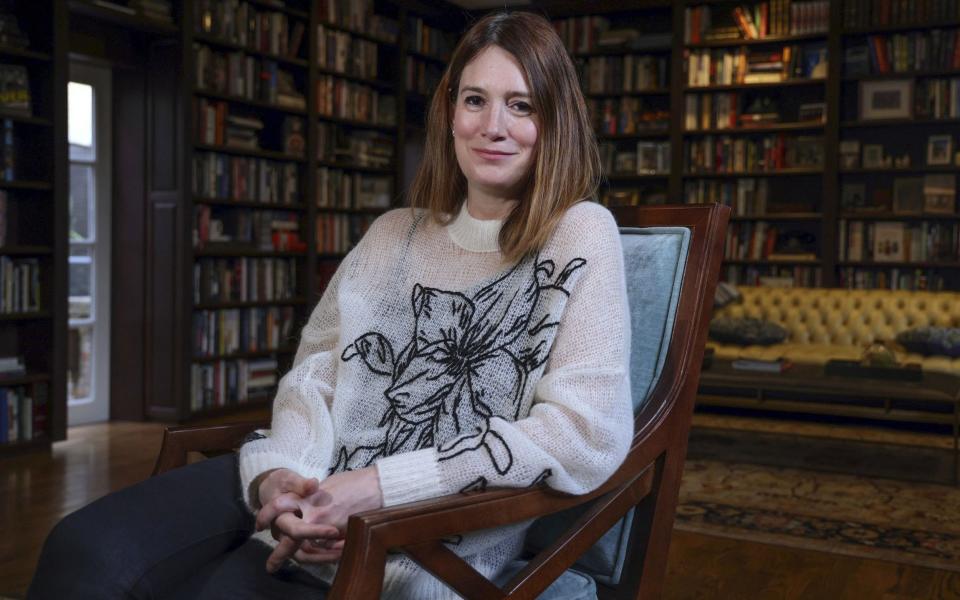How Gone Girl became a true crime sensation – without being true

- Oops!Something went wrong.Please try again later.
- Oops!Something went wrong.Please try again later.
The 2012 novel Gone Girl was one of the publishing sensations of the 21st century. Gillian Flynn’s crime thriller sold 20 million copies worldwide, topped the New York Times bestseller list and was turned into a 2014 film starring Rosamund Pike and Ben Affleck.
The twisty plot – as if you didn’t know – centres on a husband who becomes prime suspect in his wife’s murder after she mysteriously goes missing, only for it to emerge that the wife orchestrated the whole thing and faked her own grizzly disappearance to teach her philandering husband a lesson. The book spawned an entire genre of similar novels involving an unreliable female narrator and invariably featuring the word “girl” in the title (The Girl on the Train, The Good Girl, Luckiest Girl Alive, Dangerous Girls). It even led to the Netflix satire The Woman in the House Across the Street from the Girl in the Window.
Now the Gone Girl phenomenon is back with a vengeance thanks to a true crime documentary on Netflix called American Nightmare. The three-parter, released this week, is taking the internet by storm and is already the streamer’s most viewed show in the UK. It focuses on the 2015 case of California couple Aaron Quinn and Denise Huskins. She was abducted from their bed one night by wetsuit-wearing attackers and he reported it to the police, only to be accused of her murder and of making the whole kidnapping thing up. The media immediately seized on the case as “the real-life Gone Girl”. And, just to ram the point home, American Nightmare is peppered with clips from the film. Viewers are losing their minds over the documentary (“Holy s---, this s--- is wild!” says a typical review on TikTok).
Twelve years on from its release, it seems that Gone Girl has become a true crime phenomenon despite not actually being true. Forget stepping through the looking glass – we have stepped through a detective’s magnifying glass into a wonky world in which a TV documentary is packaged as a real life version of a film that’s based on a work of fiction. American Nightmare is far from alone.
Numerous disappearance cases over the years have been compared to Gone Girl, while the term “Gone Girl faker” has become something of a tabloid tagline. What’s real any more? Who’s imitating who? It’s hard to tell. The only thing for certain right now is that Netflix has a sure-fire, watercooler-moment, copper-bottomed hit on its hands. Call the cops.
Flynn has always been at pains to point out that Gone Girl is a work of fiction. Speaking to Entertainment Weekly in 2012, the author stressed that her novel was based on no specific cases from the past. The word “specific” was doing a lot of the heavy lifting there. Because Flynn, a self-confessed “true crime addict”, went on to say that one real-life case had been something of an influence on her book. In the early Noughties the story of Scott and Laci Peterson had gripped America.

In December 2002 when eight months pregnant, Laci Peterson disappeared from the couple’s California home (always California). Her husband Scott reported her missing and her remains were discovered the following April near San Francisco. He was arrested and charged with her murder and that of their unborn child (he is currently serving a life sentence but has always maintained his innocence) Flynn believes the case hit the headlines in part because the couple were good-looking (“you don’t normally see incredibly ugly people who’ve gone missing and it becomes a sensation,” she said).
And so the couple in Gone Girl, Nick and Amy Dunne, are an attractive couple, as – naturally – are their screen alter egos Affleck and Pike. But there was another conceit that Flynn was playing with: the assumption that it’s always the husband who dunnit. “A wife goes missing; you assume that the husband did it. To me, that was a very interesting idea,” she told Entertainment Weekly.
Gone Girl toyed with this assumption to great effect. But it was once the published novel became a yardstick against which other cases were compared that things got really interesting. In 2016 Sherri Papini disappeared while on a jog in Redding, California. Around three weeks later the married mother was found 150 miles away with a chain around her waist, bruised legs, a shaven head and a broken nose. Hose clamps where fixed to her ankles and she’d been branded on her shoulder.

She said she’d been abducted by two gun-wielding Hispanic women who tortured her. None of it was true. The investigation took six years. But in 2022 Papini confessed that it was a hoax. She’d been with an ex-lover all the time. “Gone Girl Copycat” was a typical turn of phrase in the tabloid coverage. In this case, the Gone Girl narrative arc had been replicated.
Things were a little different in a case a few years later though. In May 2019 a mum from Connecticut (with apologies to California) called Jennifer Dulos went missing. Her estranged husband Fotis Dulos became prime suspect. This suspicion grew when Fotis and his girlfriend were allegedly caught on video disposing of bin bags containing bloody clothing in numerous different bins (never a good idea when your wife has disappeared). But in an unexpected move, Fotis Dulos used Gone Girl in his defence against the accusations.
His attorney Norm Pattis suggested to the New York Post that Jennifer had staged her own disappearance in a Gone Girl-like move. He told the newspaper that she had previously penned a manuscript that bore some resemblance to Flynn’s book. He also told NBC News that “we don’t know what had become of Jennifer but the ‘Gone Girl’ hypothesis is very much on our mind”.

Flynn’s book had become a legal tool. Jennifer’s family heavily criticised the line of defence, as did Flynn herself. “It absolutely sickens me that a work of fiction written by me would used by Fotis Dulos’s lawyer as a defence, and as a hypothetical, sensationalised motive behind Jennifer’s very real and very tragic disappearance,” the author said. Fotis Dulos took his own life in 2020 while Jennifer’s body has never been found. Dulos’s girlfriend, Michelle Troconis, is currently on trail for helping in an alleged coverup, conspiracy to commit murder, evidence tampering and hindering prosecution; she insists she doesn’t know what happened to Jennifer and has pleaded not guilty.
Which brings us to American Nightmare and the latest iteration of the Gone Girl twist. If you haven’t seen it yet, stop reading here: spoilers follow. Because the memorable thing about Quinn and Huskins case is that there is no Gone Girl twist at all. The big reveal is that Aaron Quinn was telling the truth all along: his girlfriend Denise Huskins was abducted absolutely as he described. She was also raped twice. The “Gone Girl” theory was introduced to the case by the police themselves and swiftly picked up by the media.
In the documentary we see the memorably-named Detective Mat Mustard (in the library, with the candlestick) accuse Quinn of abducting his girlfriend and letting her body rot. Mustard later interrogates a clearly traumatised Huskins in a police interview room with sickeningly little compassion. Huskins’ incredulous lawyer tells the programme that an FBI agent called David Sesma asked him at one point, “Haven’t you seen the movie Gone Girl?”
The lawyer tells the documentary, “How could this person who is charged with investigating crime think that this is like a Ben Affleck movie? That’s Hollywood. This is real life.” The lawyer alleges “confirmation bias”: the police were so sure of their “Gone Girl” theory that nothing would dislodge it from their minds.
An ex-Marine named Matthew Muller was found guilty of rape and false imprisonment in March 2016 and is currently serving a 40-year sentence. Quinn and Huskins sued the police department. They were awarded $2.5 million in an out-of-court settlement.

But the on-screen plot twists – and there are many – are only one reason American Nightmare is proving so popular. As viewers we become part of the conspiracy. We find ourselves making assumptions about people’s guilt – and are made idiots of in the process. Just like the police, we’ve got Gone Girl-itis. From the comfort of our sofas we all think that the boyfriend did it. Of course it was him. More fool us. And then once we know the truth, we rage at the injustice of it all, at the callousness of a big institution we innately assumed we could trust (shades of Mr Bates vs The Post Office here). We also weep at the happy ending.
Gone Girl-related television is showing no sign of disappearing. In 2016 Flynn said the novel that inspired her book was the 1978 YA mystery novel The Westing Game by Ellen Raskin. This book is about a wealthy businessman called Sam Westing who dies and charges his 16 heirs with finding out which one of them killed him. The heirs – all of whom live in the same apartment block – are coupled up into eight pairs, and the pair that solves the mystery will inherit his $200 million and his business. It sounds like a cross between Only Murders in the Building and Knives Out, both hugely popular. In 2020 it was announced that HBO was working on a series adaptation of The Westing Game.
So the nexus where true crime and Gone Girl-style “unreliable narrator” stories meet looks set to be a TV sweet spot for a while to come. They have become a blended genre. Real life? Fiction? Viewers don’t mind. As one of Huskins’ neighbours told an ABC 7 News bulletin after she went missing, “Sometimes life is stranger than fiction.” And we are lapping it up.

